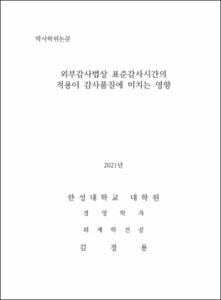외부감사법상 표준감사시간의 적용이 감사품질에 미치는 영향
= Effect of Application of Standard Audit Hours on Audit Quality under External Audit Act
- Type
- Thesis
- Department
- 대학원 경영학과
- Issued Date
- 2021
- Publisher
- 한성대학교 대학원
- Keyword
- 표준감사시간; 감사품질; 감사시간; 분반기검토시간(비중); 상위직급감사인감사시간(비중)
- Files in This Item:
-
-
Download
 200000360745.pdf
기타 데이터 / 1.32 MB / Adobe PDF
200000360745.pdf
기타 데이터 / 1.32 MB / Adobe PDF
-
Items in Repository are protected by copyright, with all rights reserved, unless otherwise indicated.